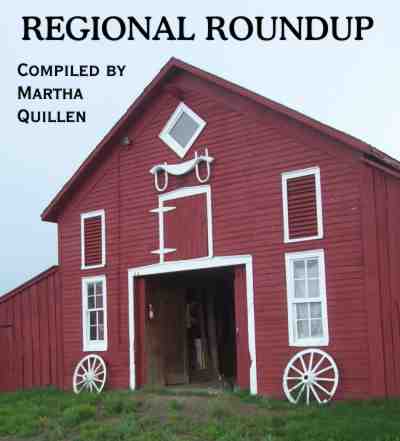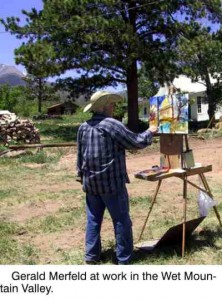Brief by Martha Quillen
Local News – September 2007 – Colorado Central Magazine
Gunnison Mine Makes Headlines
A mine cave-in in Utah recently led to a nation-wide review of safety conditions in coal mines, and The Denver Post concluded: “While the safety record of Utah’s Crandall Canyon Mine, where six workers remain trapped, has come under scrutiny, Colorado’s own Elk Creek Mine has a more significant record of safety issues, according to federal data.”

This year, the Elk Creek coal mine in Gunnison County, “has received 155 citations from the federal Mining Safety and Health Administration,” and 62 “of those violations were deemed ‘significant and substantial,’ ones that could result in injury and death.” Problems included “coal-dust buildup, inadequate ventilation, excessive methane, and poor maintenance and operation of equipment, including fire extinguishers.”
The rest of the August 9 Post article included interviews with experts and clearly showed that there was a major divide in opinion about mine conditions. Bob Butero, the regional director of the United Mine Workers of America, and Davitt McAteer, the former assistant secretary (under Clinton) of the Mining Safety and Health Administration both concluded that a history of citations for serious mine safety violations indicate imminent danger.
But Stuart Sanderson, the president of the Colorado Mining Association, says Elk Creek has a better safety record than the national average. And Jim Cooper, the manager at Elk Creek, says his mine is safe, and claims the industry is being unfairly singled out. “I think a lot of citations hinder safety conditions at a mine,” he said. “If they have to deal with answering citations, it’s a waste of time.”
A separate article about the Crandall Canyon Mine rescue in the same newspaper showed how dangerous, uncertain, and emotionally volatile rescue operations can be.
Hantavirus Kills Three Coloradans in July
Hantavirus killed three Coloradans in the space of a single week this July, bringing the 2007 death toll to four as of August 10.
In May, the illness took the life of a 28-year-old Alamosa County woman.
On July 8, hantavirus killed a woman in Costilla County. On July 9, Fred Sharp, 66, of Custer County died of complications of hantavirus at a Pueblo Hospital. On July 15, Jason Dinges, a 20-year-old CU student at home in Park County for summer vacation, died of the virus.
Hantavirus is carried by deer mice, which generally live in rural areas. Humans can get it from mouse droppings or urine or from dust and dirt contaminated with mouse feces or urine. Human cases occur most frequently in May, June and July. To avoid exposure, experts recommend eliminating rodents with poison or traps; rodent-proofing buildings with sealants and repairs; proper food storage, storing firewood away from homes; keeping vegetation around homes trimmed; and using caution and a bleach mixture when cleaning sites which might be contaminated.
The illness begins with a high fever, severe body aches, a headache and vomiting from one to six weeks after exposure, then progresses to trouble breathing and/or shortness of breath. Common cold symptoms like phlegm, runny nose and sneezing are not usually associated with the virus.
Human Remains Investigated
Human remains found by a fisherman near the Arkansas River on July 18 are being investigated by historians rather than crime scene experts, because apparently erosion desecrated an old gravesite, allowing the remains to wash downstream.
Found with the human bones at the site, north of Granite near the Twin Lakes turn-off, were rotted wood and square iron staples, which were thought to be from a coffin, and also corroded brass buttons. After preliminary investigations, it was thought the buttons were manufactured between 1855 and 1861, back when Colorado was still a territory, and may have been on the uniform of a cavalry officer with the First Regiment of Dragoons.
Digital pictures were sent to the Smithsonian Institute to further identify the buttons in the hope that they will help identify the skeleton, which may thereby secure a plot in a military cemetery.
Renaissance or Dark Ages?
On July 29, the front page of the business section of the Denver Post featured a story about “Salida’s renaissance.” The story told of recent investments in downtown Salida properties, soaring prices, and “overcoming long decline.”
Investors and residents enthusiastically talked about plans for a new conference center, a 50-room hotel, luxury condos, a “boutique” department store, renovations, and more.
Naturally enough, however, not everyone was happy about escalating real estate prices. The story also featured residents who were appealing increased tax assessments and were worried about whether anyone can really afford such rapidly rising rents.
“It’s very tough to pass on those kinds of increases to your tenants and be expected to fill your building,” said Merrell Bergin, a property owner.
And former mayor R.T. Taylor, said: “It’s turning into a greater fools’ market. Somebody’s always going to pay more, and eventually it will become a playground for rich people.”
Local Newspaperman Hospitalized
Merle Baranczyk, 60, the editor and publisher of the Salida Mountain Mail, was airlifted to St. Anthony Hospital in Denver after he crashed into a van while riding his bike on the shoulder of U.S. 50. The driver of the van turned in front of Baranczyk to enter a private driveway.
Baranczyk is also the publisher of the Chaffee County Times, Fairplay Flume, and Leadville Herald-Democrat, and owns Arkansas Valley Publishing, which prints many local guides, brochures, and publications, including Colorado Central.
According to the Mail, Baranczyk received serious head and skeletal injuries, but was up and walking within a few days of the accident. We wish him a complete and speedy recovery.
Suspect Prefers His Own Counsel
At a motions hearing on July 23, suspect Robert Amos, who faces charges in connection with the death of Alyssa Heberton-Morimoto, a 24-year-old Denver woman who was killed in the Pike National Forest near Fairplay, asked the court to dismiss his public defender, Patrick Murphy. Amos said he wanted to represent himself.
Asked what he knew about court procedures, Amos admitted it was very little, but he refused to accept advisory council when Judge David Thorson suggested it.
According to the Fairplay Flume, “at times during the proceedings, Amos raised his voice and used profanity, sometimes apologizing for his outburst.” Although the judge “accepted Amos’s constitutional right to represent himself,” Thorson warned Amos that he’d be giving up more than he’d be gaining, and told Amos that he would still be provided with a public defender if he wanted one in the future.
Amos’s next court appearance was scheduled for three weeks later, whereupon, the Flume reported, Amos wondered why it couldn’t be sooner. “I’m old and I’m tired,” Amos said. “I’m 45 years old, and I’m dying of cancer. I want to do something right before I die.”
Shorts
* Completion of Phase 1 restoration for the Huchinson Homestead on West U.S. Highway 50 between Poncha Springs and Salida was celebrated with an open house. Thus far the building has gotten a new foundation, roof, and paint, and windows and doors have been restored. Future plans call for more stabilization and restoration, interior work, and a visitors’ center with pathways and parking.
* According to the Herald Democrat’s police blotter, on July 10, police officer Troy Hardwick picked up two 14-year-old boys who were setting off fireworks in a Leadville alley during the wee hours of the morning. Hardwick commented that they smelled of alcohol, but both denied drinking; one of them, however, told the officer that his sister had been imbibing. Hardwick pointed out that the sister was not in the car, and the boys confessed to having downed four or five shots of whiskey. They were subsequently charged with loitering and underage consumption of alcohol.
* Tired of having soccer balls continuously hit her home in a trailer park on U.S. 24, a 55-year-old Lake County woman refused to return some soccer balls when asked. According to the Sheriff’s log in the Herald Democrat, a 25-year-old man was subsequently charged with third-degree assault for beating the woman.
* For the first time ever, a woman came in first in the open division of the 2nd leg of the Triple Crown International Pack Burro Race at Leadville. On the steep, high-altitude 22-mile course, Leadville winner Lynette Clemons was accompanied by a jenny named Boogie, which is also a first ever win for a female, according to Herald Democrat editor Marcia Martinek. Hal Walter, of Colorado Central fame, came in first in the Fairplay race, second in the Leadville race, and third in the Buena Vista race (where Bill Perkins finished first in the men’s division).
* Tiny Alpine (in Chaffee County off the road between Mt. Princeton and St. Elmo) made it into state and national news after 98 residents were evacuated on July 21 due to heavy rain and mud slides. Flowing muck and debris damaged homes, roads, outbuildings, and vehicles. Two days later, Alpine residents returned to assess the damage and clean things up, but were cautioned to have their water and propane tanks tested before use.
* A proposed U.S. Forest Service directive could ban biking and motorized travel on the Monarch Crest trail. The Continental Divide Trail was primarily established for travel on foot and horseback, but the section known as the Crest Trail is currently a wildly popular mountain biking route. In fact, it’s so overcrowded with bike traffic that horseback and pedestrian travel seem to be adversely affected. Thus, reforms are being considered, and public comments will be accepted until October 12. For more info see: http://www.fs.fed.us/r2/projects/cdnst_directive/index.shtml.
In the wake of the bridge collapse in Minnesota, CDOT was out inspecting steel-deck truss bridges in Colorado and found a fracture in an angle connector on the Johnson Village bridge ( U.S. 24 and 285). Traffic was reduced to a single lane for a short time, but it was thought welding could repair the problem — at least temporarily. More extensive repairs may be necessary, but long-term plans haven’t been determined yet.
Quotes
We try to keep fees low enough so everyone can get into the park. If we raise them too much, we’re going to price people out . . . We’re trying to avoid being Disneyland.
Larry Kramer, deputy director of Colorado State Parks, Rocky Mountain News, Aug. 4
We like it here; it’s where we want to be. Everything you believe in is right out there. That’s my church.
George Draper, rancher, Wet Mountain Tribune, July 26
Tim Glenn said the crematory would allow the funeral home to offer a service the community needs and deserves.
Ali Helgoth, Mail Staff Writer, Mountain Mail, July 31
Approaching Canon City from the west, I shudder. Their Master Plan designed to manage development must be moldering in some bottom drawer.
Doris Dembosky, Wet Mountain Tribune, August 9
If you find fault, don’t dwell on it!
Headline on story about geology presentation, Crestone Eagle, August


